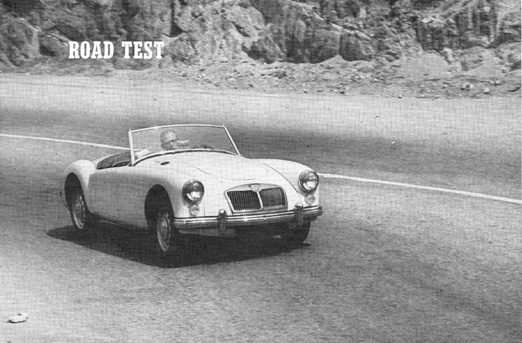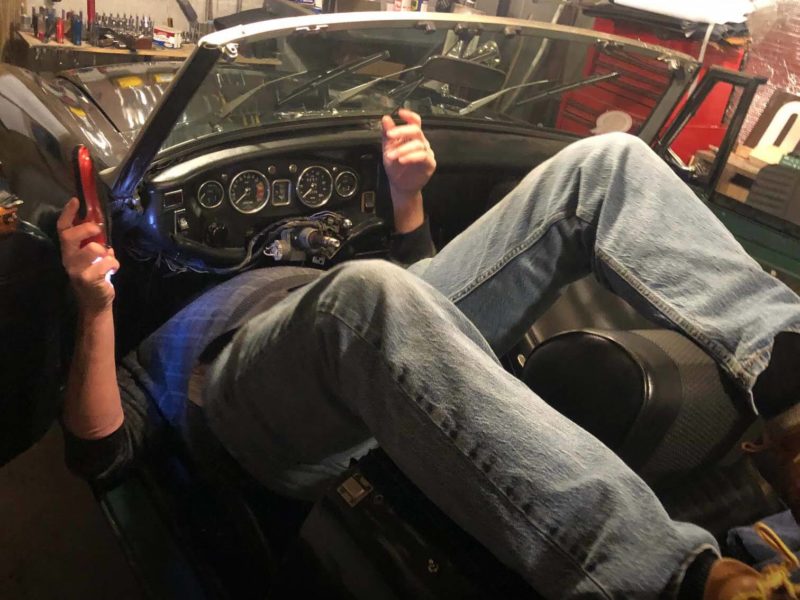From Motor Trend — October 1961
Author unknown
This latest variation of the sports car pioneer reemphasizes all of the factors that have made it a best seller.
In the jargon of the advertising trade, MG has created for itself a “favorable public image.” Favorable in this sense means that the MG is automatically recognized as a sports car by the U.S. motoring public. No one need make any excuses or qualify the term in any way—the MG fits. This has been true since 1948, when the cars first began to be imported to the U.S. as the TC series, and has held through the TD, TF and A groups—some 125,000 cars imported in all. Why? Simply because the MG is a true sports car. In its price category it has come to be the standard against which other sports cars or would-be sports cars are judged.
 The significance of the MG, the fact that MOTOR TREND had not performed any sort of test on one since September 1959, and the introduction of a new model for the A series, the 1600 Mark II, added up to an MG test. As with all cars, there are shortcomings and advantages. Pointing them out in an objective fashion should enable us to place the car in proper perspective with other sports machines and gain some indication as to its suitability for the widely varying conditions in the U.S.
The significance of the MG, the fact that MOTOR TREND had not performed any sort of test on one since September 1959, and the introduction of a new model for the A series, the 1600 Mark II, added up to an MG test. As with all cars, there are shortcomings and advantages. Pointing them out in an objective fashion should enable us to place the car in proper perspective with other sports machines and gain some indication as to its suitability for the widely varying conditions in the U.S.
Outwardly, the Mark II has had a simple face-lifting around the grille and taillights; it retains the basic A roadster silhouette and dimensions. Key sizes include 94-inch wheelbase, 47.5- and 48.75-inch front and rear tread, 156-inch overall length, 58-inch width and 50-inch height. Under the hood is the biggest change, some 10 more horsepower than the 1600. Acceleration is slightly better, while top speed has been raised to considerably over 100 mph (107, factory rating) and engine durability is said to have been increased. From the driver’s view there is little interior change except for increased use of leather trim in the dash area. Handling characteristics remain appreciably the same as in previous A’s.

MG-A’s 1600 is powered by a variation of British Motor Corporation’s B model engine. Bigger displacement, higher compression, other changes improve performance.
The engine, a variation on the British Motor Corporation’s B model, has gained a well-deserved reputation for reliability. With the changes that stamp it a Mark II, it should prove even better. Compared to the previous 1600, it has been bored .03-inch, increasing displacement 2.1 cubic inches to 99. Intake valves are nine per cent bigger, exhausts up 11 per cent with ports revised to take advantage of the extra valve area. Compression is up from 8.3 to 8.9 with horsepower up to 90 and torque raised 10 lbs.-ft. to 97 at 4,000 rpm. Piston pins are slightly larger, therefore stiffer; connecting rods have been increased in the H-section for greater stiffness, and the crankshaft webs are 1/8-inch thicker, which means that the main bearings are narrowed slightly.
More important to the consumer than the relatively minor engineering changes is how the engine performs under varied conditions—creeping traffic, high speed, mountain grades, broiling desert, sub-zero or any other condition likely to be encountered. It is impractical to perform a test including all climes; in Southern California, however, it is possible to find all of them except the latter. Generally, the MG’s engine took it all in stride. No tendency to overheat was observed in traffic, hot open country or climbing hills, although an unpleasant amount of warmth was generated and passed through the transmission tunnel into the cockpit. Idle was smooth and regular, with cold starting simply a matter of brief choking. Hot starts, often a sports car problem, were virtually instantaneous.

Changed qrille is one of the few external changes in the new MG. But the engineering differences have made many changes since last MT road test.
The MG-A makes a nearly ideal sports car for the beginner. By that, it is not meant to limit the car’s usage to novices at sports motoring; many of the marque’s biggest boosters have owned several and would have nothing else. The reference is intended for the owner who has the urge and finances to go racing on an expensive scale, yet recognizes the fact that there must be a learning period in something relatively safe. (Many competition drivers have, in fact, derived so much pleasure from racing in closely matched production MG events that they have not bothered to step up.) The characteristics that make the A a good learner’s car also make it a delightful general purpose street machine. The car was felt to be a well integrated unit that is, gearbox, handling, ride, brakes, acceleration and performance generally were all part of the same car. No one feature was so outstandingly bad or good that it was considered to be either a total detriment or the starting point for another and better car.
At 2 2/3 turns, lock-to-lock, the rack-and-pinion steering is quick and sensitive. Except for the low number of turns, it will be found to be little different from typical domestic late models under normal driving conditions. Wheel action is slightly heavy at low speeds, easing up as speed is increased. There is a desirable tendency to understeer, which means a definite wheel return action while straightening out. At higher racing-type speeds, it is quite easy to break the rear wheels loose in a corner and hold them out by applying power. Easing off induces the rear end to come around more sharply and the car will spin unless steering correction is applied, but it is all telegraphed to the driver- nothing tricky or difficult as in the case of some extremely high-performance sports cars. The result is that it is an easy task for a beginner to safely learn racing techniques, provided an open practice area is available. Such knowledge, essential on the race course, can be invaluable in a highway emergency. Not the least of safe, fast cornering is a low amount of body roll; it will be imperceptible to a driver who has been used to larger, softly sprung cars.

Well-instrumented interior has changed little. True to sports car design, MG has low seats, adjustable steering wheel and minimum closed-car accessibility.
When one considers emergencies, brakes are uppermost. The A has 11-inch-diameter discs on the front, with 10 x 1 3/4-inch drums on the rear. Brake pedal pressure is moderate, they do not fade under repeated high-speed stops and they continue to stop in a straight line. There is little else that can be said about brakes that perform as good brakes should.
One of the oft-touted joys of driving a sports car is shifting through a four-speed gearbox, not simply for arm exercise but for control such as most automatics cannot give. The MG-A will satisfy the enthusiast on that point. The tunnel-mounted lever is positioned in excellent relationship to the wheel. Synchronized on the top three gears only, it was felt that gear action was slightly stiff. Compensating for that is a good choice of ratios and short throws with practically no slop in the remote linkage. Considering engine size, shifting can be held to an absolute minimum if one desires. For example, it was entirely possible to pull smoothly in fourth gear from 1,000 rpm, equal to 17.85 mph. Such treatment is not recommended, but it can be done. Ideal use of the gears involved keeping revs above 2500, with 3,000 a happier choice. Between 3-5,000, incidentally, the acceleration response was quite lively.

Throttle linkage inside the passenger compartent is a carryover from right-hand-drive European version.
Shifting, especially downshifting, a sports car can become a sort of lightfooted ballet for the experienced driver who has mastered the heel-and-toe technique, which means to use the accelerator to synchronize engine with gears while simultaneously braking. It can be done in the MG, using an edge-of-foot style rather than true heel and toe, but the pedal spacing was considered crowded. This has always been true with MGs, at least since TC days, and a driver with a broad foot must be constantly alert to be certain of hitting the correct pedal.
While the acceleration times recorded were not sensational, they are quite creditable, matching the factory’s acceleration curve. The car was definitely capable of staying with any traffic—ahead of much of it. Taking off, it was almost too easy to induce wheelspin in first gear. A fast shift to second produced a solid clutch bite but no wheelspin, and so on through the gears. Only when shifting at deliberately abusive speeds was there any evidence of slippage in the eight-inch-diameter clutch. and this when the clutch was engaged while the engine was still turning in excess of 5,000 rpm. Clutch pedal pressure is moderate on a reasonably short travel. Acceleration figures were taken using a rev limit of 5800-6,000 in the gears. The limit was determined by the MG’s tachometer, which has an amber segment beginning at 5500, showing red between 6-7,000 rpm.
Seating was judged to be good; even those who preferred chair-high seats quickly became accustomed to the MG’s seats. which are only 8 1/2 inches from the floor at the highest point. This means legs out, but there is plenty of length in which to stretch out while an eight-inch travel on the seat adjustment accommodates most heights to the pedals. The steering wheel. too, is adjustable. However, an extremely long-legged driver who prefers the wheel close to the dash for an arms-extended driving position will probably find some wheel/knee interference. The foam cushions, 18 1/2 inches wide by 21 long, give good knee and thigh support. Backrests, mildly contoured, have good holding power; also a center armrest adds to one’s sense of security from sliding.

Small trunk is best suited for around town
errands. Longer trips with
luggage will require an outside rack.
There are a couple of areas where the A can be criticized, but they become subjective matters of individual taste. As an example, cockpit storage is definitely at a minimum. There are door pockets only. Space behind the seats is taken up with top (when folded) and side curtains, which fit in a hanging pocket. The small trunk is rated at 5.75 cubic feet, and even this is best suited for soft parcel storage. Two persons planning any touring would be well advised to add an external luggage rack. While the top is weathertight when used with the sliding window curtains, erecting it is not a detail that can be completed by one man while remaining seated in the car. It is an awkward operation for one person and is much more easily performed by two.
Ride is another subjective area that is difficult to pin down, but it was concluded that the MG’s ride, while firm, is good. There is practically no tendency to choppiness, often felt in tightly-sprung, short-wheelbase cars. Even during off-pavement driving the suspension soaked up bumps and holes in a gratifying manner.
High noise level and wind buffeting can be companion features of small open cars. Both have been held to a minimum in the MG. Because the driver sits quite low in the body, top-down driving is reasonably wind-free. There was actually more annoying wind noted with the top up and side curtains out. Engine noise is moderately high, a distinctive note recognizable as MG. One saving grace is that the exhaust noise is not fatiguing at high cruising speeds.
During a period when it has become the fashion to build cars with unit construction, whether any advantage is realized or not, the MG clings to a separate box-section frame with body bolted on. It doesn’t seem to create any particular weight penalty as compared to the possibilities of a unitized bodyframe. Suspension is quite conventional, upper and lower A-arms at front with coil springs and Armstrong lever shocks.
Anti-roll bar is optional, although there was none on the MOTOR TREND test MG. Rear suspension of the solid axle is via a pair of six-leaf semi-elliptic spring and double-acting Armstrong lever shocks. Panel fit and finish, which can spell the difference between consumer satisfaction and disgust, were found to be good. The off-white paint was well applied, doors closed solidly and hood and deck were installed to close tolerances.
The base price shown, $2499, can be raised through a number of desirable extras, including wire wheels at $100, tonneau cover $35, heater $65, windshield washer $15, and whitewall tires $35. Anyone considering the MG strictly as an economy car should probably look elsewhere; there are other small roadsters and numerous sedans that will deliver better fuel mileage. But as a fun car, an automobile that features basic driving pleasure, it is hard to beat. The limitations of a two-seat roadster are quite obvious. If these can be overlooked, the MG-A 1600 Mark II is an outstanding automobile for the money.
 TEST CAR: MG·A Mark II 1600
TEST CAR: MG·A Mark II 1600
BODY TYPE: Roadster
BASE PRICE: $2499
ENGINE TYPE: Ohv 4
DISPlACEMENT: 99 cubic inches
COMPRESSION RATIO: 8.9 to 1
CARBURETION: Two single-throat SU
HORSEPOWER: 90@ 5500 rpm
TRANSMISSION: Four-speed manual
REAR AXLE RATIO: 4.1
GAS MILEAGE: 17 to 21 miles per gallon
ACCELERATION: 0·30 mph in 3.9 seconds, 0-45 mph in 7.3 seconds and 0-60 mph in 14.2 seconds
SPEEDOMETER ERROR: Indicated 30, 45 and 60 mph are actual 28, 41 and 55 mph, respectively
ODOMETER ERROR: Indicated 100 miles is actual 98 miles
WEIGHT-POWER RATIO: 22.8 lbs. per horsepower
HORSEPOWER PER CUBIC INCH: .91








'MGA 1600 MkII: Original Review 1961' have 10 comments
January 11, 2014 @ 9:28 am Rod T
I just purchased my third MGA1600 mk2. In the past forty plus years, I have owned several MGBs, a handful of TR6s , and one TD, but the only model I ever regret parting with was the 1600 mk2. They are simple, yet classic and a joy to own and drive. I plan on keeping this one for long time.
January 11, 2014 @ 9:32 am Rod T
Thanks for printing this great article!
October 8, 2015 @ 5:17 am Stephen Saracino
I recently purchased a 1961 MGA. How would one ascertain if it is a MKII? Thank you.
October 28, 2015 @ 10:45 am Pete
The MKII has horizontal headlights, recessed grille, and leather covered dashboard.
December 30, 2017 @ 6:12 am Sean Galbally
You mean horizontal REAR lights.
November 26, 2022 @ 7:39 pm Harold Labonte
In 1969 I luckily traded my vw beatle to a young woman even trade for her 1961 MGA mark 2. Many challenges owning a 8 year old sports car in the winters of New Hampshire, wonderful memories in my first British sports car. Followed by many since
October 12, 2017 @ 10:12 pm Tom Walliman
It’s indeed a great thing that this MG has low wind noise and buffeting. Usually small open cars are notorious for being extremely noisy at highway speeds unless a good draught-stop like the Backblade wind deflector is mounted. Mine was a classic example of this issue but not after affixing the wind deflector.
December 30, 2017 @ 12:05 am John
I own a 1962 MKII MGA, what a pleasure to drive. I love how these cars handle and the sound of the engine is definitely British. A lot of car for the money.
September 26, 2018 @ 1:42 pm Dave
This spring I just finished my rebuild of a 1962 MGA barn find. All the parts for the restoration have come from Moss. Any problems I had, which was only one out of the hundreds of parts purchased, Moss immediately took car of. I originally purchased the car to flip, but after the sorting out period, I am keeping it as it is such a joy to drive.
September 18, 2020 @ 8:44 am Marcus Bates
What is the proper head for the 1600 cc MGA engine? Mine has a 1500 head.